DOI:10.32604/cmc.2021.018808

| Computers, Materials & Continua DOI:10.32604/cmc.2021.018808 |  |
| Article |
A Lightweight Anonymous Device Authentication Scheme for Information-Centric Distribution Feeder Microgrid
Department of Computer Science and Engineering, New Mexico Institute of Mining and Technology, Socorro, 87801, NM, USA
*Corresponding Author: Jun Zheng. Email: jun.zheng@nmt.edu
Received: 22 March 2021; Accepted: 23 April 2021
Abstract: Distribution feeder microgrid (DFM) built based on existing distributed feeder (DF), is a promising solution for modern microgrid. DFM contains a large number of heterogeneous devices that generate heavy network traffice and require a low data delivery latency. The information-centric networking (ICN) paradigm has shown a great potential to address the communication requirements of smart grid. However, the integration of advanced information and communication technologies with DFM make it vulnerable to cyber attacks. Adequate authentication of grid devices is essential for preventing unauthorized accesses to the grid network and defending against cyber attacks. In this paper, we propose a new lightweight anonymous device authentication scheme for DFM supported by named data networking (NDN), a representative implementation of ICN. We perform a security analysis to show that the proposed scheme can provide security features such as mutual authentication, session key agreement, defending against various cyber attacks, anonymity, and resilience against device capture attack. The security of the proposed scheme is also formally verified using the popular AVISPA (Automated Validation of Internet Security Protocols and Applications) tool. The computational and communication costs of the proposed scheme are evaluated. Our results demonstrate that the proposed scheme achieves significantly lower computational, communication and energy costs than other state-of-the-art schemes.
Keywords: Mutual authentication; information-centric networking; named data networking; distribution feeder microgrid; smart devices; AVISPA; security
Smart grids. provide a more reliable and efficient power supply than traditional power grids by incorporating advanced information and communication technologies (ICT) [1,2]. Microgrids are a subset of smart grids that achieve grid deployment in small regions. A microgrid acts as a single controlled entity that is formed by a group of interconnected load and demand resources with communication and control capabilities [3]. It has a well-defined electricity boundary with a limited number of connection points to the utility grid such that it can operate in either grid-connected or islanded mode.
Distribution feeder microgrid (DFM) has been proposed as a solution of modern microgrid which is built based on existing distribution feeder (DF) [3,4]. DFM utilizes advanced communication, control, and protection technologies to increase the sustainability, reliability, and resiliency of the grid and support very high penetration of distributed energy resources (DERs) [3,5]. The architecture of DFM is illustrated in Fig. 1, which contains a variety of demand and load entities such as consumer appliances, generators, energy storage, electrical vehicles (EVs), DERs, smart meters, synchrophasor devices etc. The DFM gateway (DG) serves as the central control and management entity that connects the DFM to the utility grid.
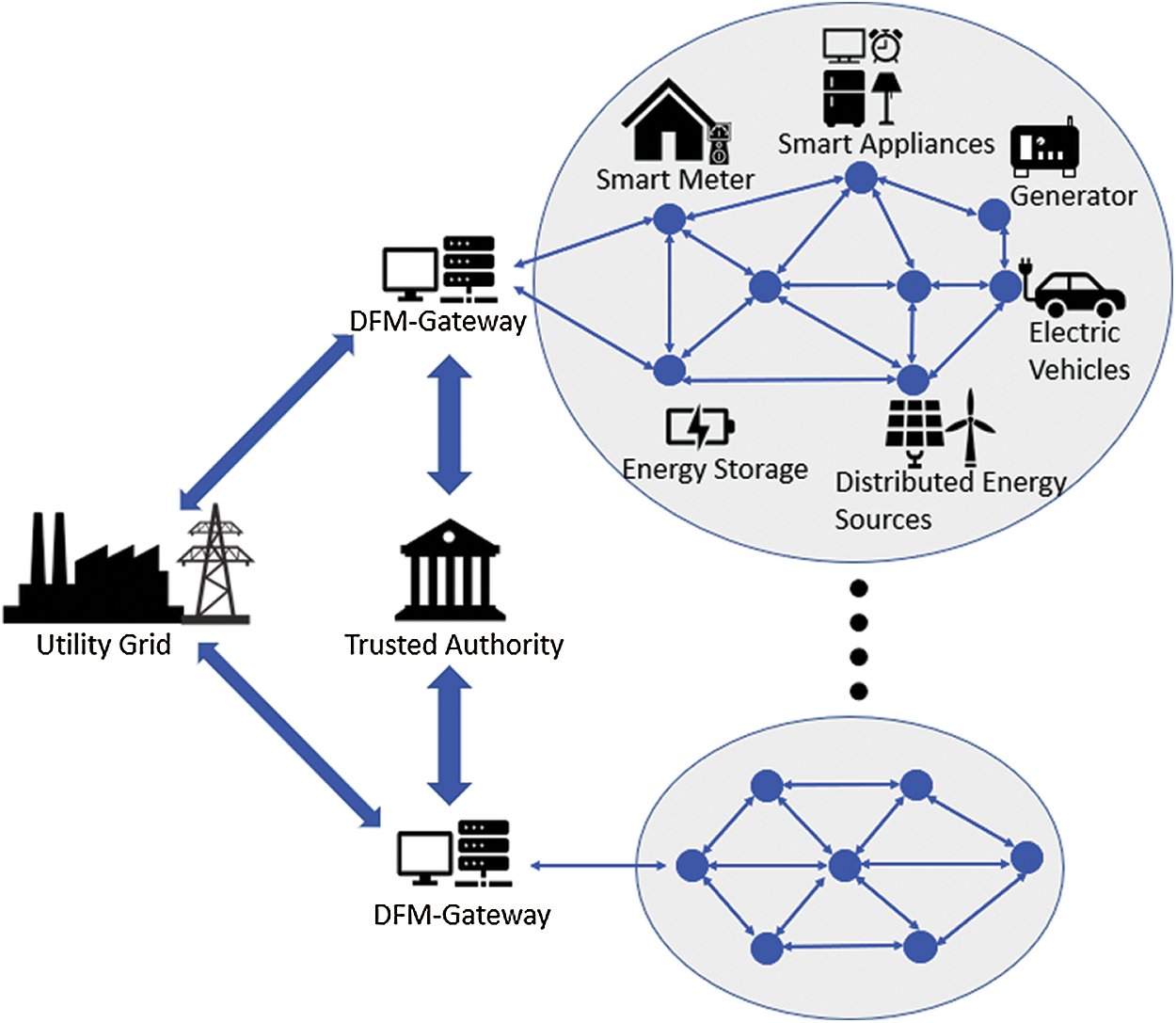
Figure 1: System architecture of DFM
One of the major technical challenges faced by DFM is the communication demand of a large number of heterogeneous devices. A scalable networking and communication architecture is needed that can meet requirements such as low data delivery latency and heavy network traffic [6]. The information centric networking (ICN) paradigm has been explored recently to address the requirements of smart grid communication [6–9]. Unlike the host-centric IP-based networking architecture, ICN adopts a content-centric communication model with novel features like data caching in network edge, data provenance, inherent multicast support, etc. which make it suitable for smart grid applications. C-DAX (Cyber-secure Data and Control Cloud) is an ICN-based solution proposed for the monitoring and control of smart grids [8]. Tourani et al. [6] proposed an ICN-based smart grid networking architecture called iCenS, which was shown to be effective in serving various types of smart grid traffic. Yu et al. [9] proposed a Content-Centric Networking (CCN) based advanced metering system (CCN-AMI) for smart grids. The CCN-AMI system is comprised of several components such as smart meters, demand response management system (DRMS), which provides better traffic congestion control, mobility and cyber security. Ravikumar et al. [7] proposed an ICN-based smart grid architecture that consists of a three-level hierarchy for information flow including physical level, aggregation level, and computation level. The hierarchy specifies constituents and the interaction mechanism at each level. The proposed architecture adopts IEC 61850 as underlying communication stack for backward compatibility and adds the Information-Centric Network Protocol (ICNP) layer. Both work of [7,9] and have conducted a comprehensive performance analysis of the proposed ICN architectures and the results show a great potential of applying ICN for smart grids.
In this paper, we consider a named data networking (NDN) based architecture to address the communication demand of DFM. NDN is a representative ICN architecture which has been shown as a promising solution for not only smart grid communication [6,7] but also the communication needs of applications of smart cities [10], smart campus [11], smart home [12], and smart healthcare [13]. In addition to communication requirements, another key technical challenge faced by DFM is to ensure the security and privacy of the grid. The integration of advanced ICT technologies in DFM makes it vulnerable to a number of cyber attacks such as man-in-the-middle (MITM) attacks, reply attacks, impersonation attacks, etc. Adequate authentication is essential for preventing unauthorized access to the grid network and defending against cyber attacks. There are lots of authentication and key agreement protocols proposed for smart grids based on IP networking architecture. For example, Garg et al. [14] proposed an ECC (Elliptic Curve Cryptography) and FHMQV (Fully Hashed Menezes–Qu-Vanstone) based authentication scheme for smart metering infrastructure (SMI). Kumar et al. [15] proposed another ECC-based authentication scheme for smart grid device and utility center communication. Chen et al. [16] proposed an ECC and bilinear pairing-based authentication scheme for smart grid communication. Zhang et al. [17] proposed a lightweight authentication scheme using symmetric cryptography, hash, and other lightweight operations.
There are some works on authentication protocols designed for ICN-based networking architectures, mainly for supporting various IoT communication scenarios. Similar to IP-based networking architecture, authentication also brings significant security benefits to ICN-based networking architecture [18]. Compagno et al. [18] proposed a secure IoT device onboarding protocol for ICN called OnboardICNg based on symmetric-key cryptography. It was shown in [19] that OnboardICNg incurs significant lower time and energy overheads compared with the design based on asymmetric-key cryptography. LASeR, a secure IoT device authentication and routing scheme for NDN-based smart cities, was proposed in [20]. The device authentication of LASeR is based on the Pre-Shared Key Extensible Authentication Protocol (EAP-PSK). For ICN based DFM, the authentication scheme should provide various security features including mutual authentication, session key agreement, defending against various attacks, anonymity, and resilience against device capture attack [15]. In addition, majority of smart devices in DFM are resource-limited which requires the authentication scheme to have low computational, communication, and energy costs.
The contributions of this paper are: (1) we propose a lightweight anonymous device authentication scheme for NDN-based DFM; (2) we perform an analysis of security requirements satisfied by the proposed scheme and formally verify its security by using the popular AVISPA (Automated Validation of Internet Security Protocols and Applications) tool [21]; and (3) we conduct a performance comparison of the proposed scheme with existing schemes to demonstrate that the proposed scheme achieves lower computational, communication, and energy costs.
The rest of this paper is organized as follows: Section 2 introduces system models and assumptions adopted in this paper. The proposed device authentication scheme for NDN-based DFM is presented in Section 3. In Section 4, we analyze security requirements satisfied by the proposed scheme followed by a formal security verification with the AVISPA tool. The performance of the proposed scheme in terms of computational, communication, and energy costs is evaluated and compared with other state-of-the-art schemes in Section 5. Finally, the conclusion of this paper is drawn in Section 6.
2 System Models and Assumptions
In this section, we introduce the network model of NDN based DFM, the threat model, and their assumptions after an overview of NDN.
NDN is a new ICN paradigm proposed as a candidate for future internet architecture. NDN assigns a unique name to a trunk of data or a so-called content object. NDN has two types of packets: Interest and Data packets. The Interest packet is issued by a consumer to request the desired data content using the unique name. The network will forward the Interest packet to the provider of the data content. The provider will reply with a Data packet back to the consumer which contains the name and actual content of the data. Interest and Data packets can have other fields besides the name of the data content. In our scheme, we only consider the name field in the Interest packet, and the name, content, and signature fields in the Data packet.
Routing of NDN is done through three data structures maintained by each NDN router: a Pending Interest Table (PIT), a Forwarding Information Base (FIB), and a Content Store (CS). The CS serves as the data cache of an NDN router. When an Interest packet arrives, the router will check if the name of the requested data content matches any record in the CS and serves the data if there is a match. Otherwise, the router will check the PIT table to avoid forwarding duplicated Interest packet. If no PIT entry can be found, the router will use the FIB table to determine the appropriate interface to forward the Interest packet. In the meantime, the PIT table will also be updated to indicate that the Interest packet is forwarded. The routing of the corresponding Data packet will simply use the reverse path identified in the PIT.
In NDN, a Data packet usually contains the name of the corresponding Interest packet. This duplication will tremendously increase the size of a Data packet when a long name is used for the corresponding Interest packet. This causes a significant problem when transmitting an NDN packet over a low power wireless link such as an IEEE 802.15.4 link due to its limited maximum physical packet size. Solutions relying on fragmentation and reassembly [22] could result in a significant increase in memory storage, processing complexity, and traffic amount. In this paper, we adopt a solution proposed in [23] that replaces a long Interest name with a short 1-byte HopID. The solution extends the PIT table with two new columns: HIDi and HIDo. For an Interest packet, each hop generates a 1-byte HopID and includes it in the name. The HopID will be stored in the HIDo column which should be unique within the local PIT table and has the same lifetime as the corresponding PIT entry. When an Interest packet arrives at a hop, the HopID will be extracted from the Interest name and stored in the HIDi column of the corresponding PIT entry. A new HopID will then be generated by the hop and stored in the HIDo column of the same PIT entry. The new HopID will be included in the name of the outgoing Interest packet. This process will be performed in each intermediate hop until the Interest is served by the producer. The producer will extract HopID from the HIDi column and use it as the name of the responded Data packet. Intermediate hops that forward the Data packet will simply extract the HopID and lookup HIDo column of the PIT table for a match. If a match is found, the hop will replace the HopID of the Data packet with the new HopID from the HIDi column of the matched PIT entry before forwarding the Data packet.
2.2 Network Model and Assumptions
We consider that all entities of a DFM shown in Fig. 1 are wirelessly connected to form a mesh network topology. The load and demand entities with communication and control capabilities in a DFM are referred as smart devices. The majority of them have limited computational, memory, and energy resources. Each device has a unique and immutable real identity such as a Silicon-ID number [24]. The deployment of smart devices is done over time. The connection of a DFM to the utility grid is done through the DG, which is considered as resource un-constrained. A smart device in a DFM may connect to the DG through a multi-hop path with the help of other devices. We also assume that a Trust Authority (TA) is existed to serve DFMs of a utility service provider as shown in Fig. 1. The TA provides authentication and authorization services to bootstrap new smart devices into a DFM network.
2.3 Threat Model and Assumptions
The basic adversary model considered for the proposed scheme is the widely used Dolev–Yao (DY) model [25]. According to the model, all entities including smart devices and DG are not trustworthy. The messages between the entities are transferred through an open channel which can be eavesdropped, intercepted, and modified by an adversary. In addition, we assume that an adversary can compromise a session key and session states according to Canetti and Krawczyk (CK) adversary model [26]. The adversary can also physically capture a device to extract the stored secret credentials by using the sophisticated power analysis attacks [27]. Finally, we assume that the TA is a fully trusted entity and can’t be compromised.
Based on the threat model and assumptions, the proposed scheme aims to satisfy security requirements including message integrity, mutual authentication and session key agreement, perfect forward secrecy, anonymity, and resistance to various attacks.
The proposed scheme consists of two phases: (1) device registration phase; (2) network discovery and authentication phase. Note that the TA is only involved in the device registration phase. Tab. 1 lists the notations and their descriptions used in this paper.

Before deployed in a DFM, a smart device S(SDS) needs to be registered offline at the TA by the owner who brings the device to the TA’s office to complete the registration through a secure channel [28]. During the registration process, SDS first sends its real identity IDS to TA. TA then generates a master secret kS and two random numbers rTA−DG, and rTA−SDS for SDS. The pseudo-identity of SDS is then computed as PIDS = H(IDS||kS). TA also computes two secrets AS = H(IDG||PIDS||rTA−DG) and BS = H(IDS||PIDG||rTA−SDS). Note that IDG and PIDG are the real identity and pseudo-identity of DG, respectively. Finally, TA sends PIDS, AS, and rTA−SDS to SDS, and then sends PIDS, BS, and rTA−DG to DG. The device registration phase is illustrated in Fig. 2.

Figure 2: An illustration of device registration phase
3.2 Network Discovery and Authentication Phase
After the registration, SDS performs the network discovery and authentication phase to join the trusted network of a DFM. The procedure of this phase is illustrated in Fig. 3 and described as follows:
• SDS generates a random number rSDs − DG and a HopID
• Upon receiving the broadcast Interest, a trusted neighbor device N(SDN) can choose to help the network discovery and authentication process of SDS or not. If SDN wants to help the process, it will extract
When the new Interest is forwarded through the trusted network of the DFM to DG, the HopID part of the Interest name will be replaced by a new HopID generated at each hop. Supposing the hop before DG is a smart device M(SDM) and its generated HopID is HopIDM, the name of the Interest received by DG will be /Auth/PIDG/PIDS/C1/PIDN/S2/HopIDM. Without loss of generality, we assume that the Interest sent by SDN will be received by DG directly.
• When DG receives the Interest, a PIT entry with the name prefix /Auth/PIDG/PIDS/C1/ PIDN/S2 will be created with the corresponding HIDi set as HopIDN. It extracts
• When SDN receives the Data packet, it first extracts HopIDN from the name and look up the HIDi column of the matched PIT entry to find the next hop’s HopID HopIDS, which will be used as the name of the new Data packet sent back to SDS. Then SDN will extract
• Upon receiving the Data packet from SDN, SDS first computes
Note that there could be multiple neighboring devices helping the authentication of SDS. For Interest packets received from different neighboring devices, DG will keep using the same rDG−SDS so that the session key between SDS and DG remains the same. DG will generate different rSDS − SDN for neighboring devices so that the session keys between SDS and neighboring devices are different.
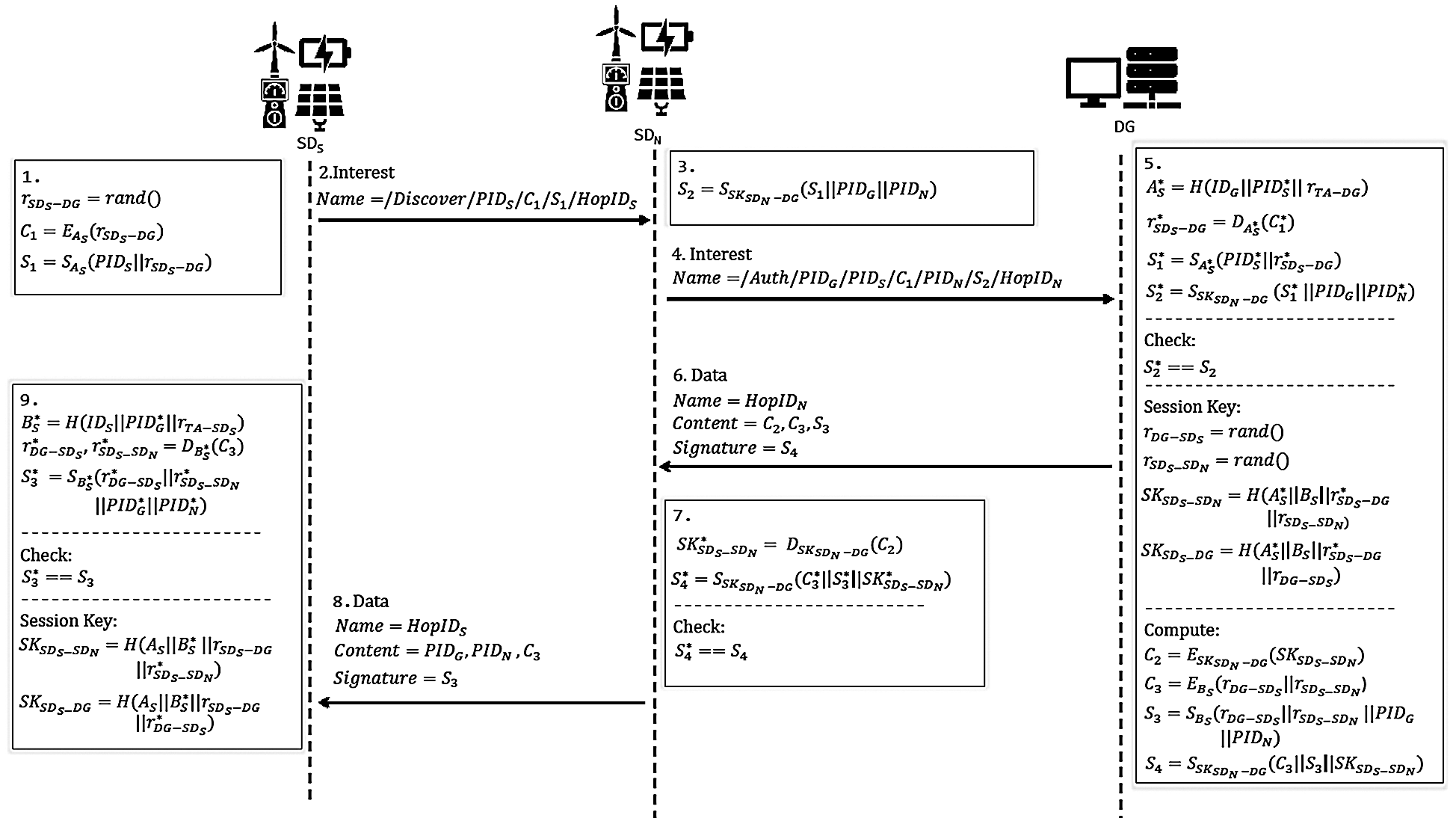
Figure 3: An illustration of network discovery and authentication phase
In this section, we perform an analysis of security requirements satisfied by the proposed scheme and formally verify its security by using the AVISPA tool.
4.1 Informal Security Analysis
Based on the threat model specified in Section 2.3, the proposed scheme can satisfy the following security requirements.
1) Message integrity: The proposed scheme generates a message signature by using the AES-CMAC algorithm to ensure message integrity. Secrets AS, BS and secure session key SKSDSN − DG are used as keys for the AES-CMAC algorithm. Since an adversary can’t obtain these cryptographic materials from intercepted messages, they can’t forge a legitimate message signature after modifying a message.
2) Mutual authentication and session key agreement: Mutual authentication is performed to verify the legitimacy of participating entities. In the proposed scheme, the mutual authentication between SDS and DG is achieved by using secrets AS and BS. DG authenticates SDS by verifying
In the proposed scheme, after performing mutual authentication for a session, a symmetric session key is established between SDS and DG as SKSDS − DG = H(AS||BS||rSDs − DG||rDG−SDS), which can be used to encrypt subsequent communication. Similarly, a symmetric session key between SDS and its neighbor SDN is established as SKSDS − SDN = H(AS||BS||rSDs − DG||rSDS − SDN), which can be used to support secure communication between neighboring devices.
3) Perfect forward secrecy: Perfect forward secrecy ensures that the compromising of long-term secret information of legitimate entities (smart devices and DG) by an adversary should not compromise the session keys established in previous sessions. The proposed scheme generates three random numbers rSDs − DG, rDG−SDS, and rSDS − SDN to compute the two session keys SKSDS − DG and SKSDS − SDN in each session. Without knowing the random numbers, the adversary can’t obtain the session keys of previous sessions. Thus, perfect forward secrecy is held by the proposed scheme.
4) Anonymity: Anonymity ensures that the real identity of an entity can’t be revealed by an adversary through intercepted messages. The proposed scheme uses a pseudo-identity for each entity that is computed from the real identity and a master secret generated by the TA. It’s infeasible for an adversary to compute the real identity without the knowledge of the master secret. Thus, anonymity is satisfied by the proposed scheme.
5) Resistance to impersonation attacks: We consider three cases of impersonation attacks for the proposed scheme:
• New device impersonation attack: To impersonate a legitimate new smart device SDS, an adversary needs to generate a valid Interest as the network discovery and authentication request broadcast to neighboring devices. However, the adversary doesn’t have the knowledge of AS to compute C1 and S1 to generate a valid Interest. Thus, the proposed scheme can resist the new device impersonation attack.
• Neighboring device impersonation attack: To impersonate a legitimate neighboring device, an adversary needs to generate a valid Interest sent to DG. However, the adversary doesn’t have the knowledge of SKSDSN − DG to compute S2 to generate a valid Interest. Thus, the proposed scheme can resist the neighboring device impersonation attack.
• DG impersonation attack: To impersonate a legitimate DG, an adversary needs to interpret a received Interest and generate a valid Data as the response which is impossible since the adversary doesn’t have the knowledge of AS and BS. Thus, it’s infeasible for an adversary to launch the DG impersonation attack.
6) Resistance to replay attacks: An adversary can intercept the transmitted messages and reply them back in a later time. In the proposed scheme, the adversary can’t generate the session keys from the intercepted messages. To generate the session keys, the adversary needs to know AS and BS, and the three random numbers rSDs − DG, rDG−SDS, and rSDS − SDN which can’t be obtained from the intercepted messages. Therefore, the proposed scheme can resist replay attacks.
7) Resistance of MITM attacks: An adversary can launch MITM attacks by intercepting the transmitted messages and try to make two legitimate entities believe that they communicate with each other directly. To make this happen, the adversary has to know AS and BS, or SKSDN − DG which are infeasible to be obtained from the intercepted messages. Thus, the proposed scheme can resist MITM attacks.
8) Resilience against devices capture attack: A smart device deployed in the wild could be physically captured by an adversary. Based on the threat model discussed in Section 2.3, the adversary can obtain the secret credentials for authentication such as PIDS, AS, and BS from a stolen device by using the power analysis attacks [27]. Such side-channel attacks are difficult to defend unless the device is tamper-resistant [29]. However, the computation of the secret credentials such as AS and BS involves IDS, a unique and immutable identity, so that they are distinct for all smart devices in the DFM network. Thus, the adversary can’t compute the session keys between DG and other non-compromising devices using the secret credentials of the captured device. Such security property is called unconditional security against device capture attack [15,24,30–32]. Therefore, the proposed scheme is resilient against device capture attack.
4.2 Formal Security Verification
In this section, we formally verify the security of the proposed scheme by using the AVISPA tool, which is designed for the analysis of large-scale internet security-sensitive protocols [21].
In AVISPA, the protocol actions and security requirements are described with a language called the High-Level Protocol Specification Language (HLPSL). AVISPA generates an intermediate file (IF) from the input HLPSL file by using the HLPSL2IF translator and passes the intermediate file to an AVISPA backend. The backend will verify the protocol security and generates a security report. AVISPA has four different backends: On-the-fly Model-Checker (OFMC), CL-based Attack Searcher (CL-AtSe), SAT-based Model-Check (SATMC), and Tree Automata-based Protocol Analyzer (TA4SP). User can choose suitable backends for protocol security verification.
HLPSL is a role-based language that contains two types of roles: basic role and composition role. Figs. 4 −6 describe the initial parameters, states, and transitions for the three basic roles (SDS, SDN, and DG) involved in the authentication process. The composition roles are specified in Fig. 7. The session role instantiates the parameters of the basic roles. The environment role contains the global variables and specifies the sessions of the protocol. Finally, the security goals of the proposed scheme are also specified in Fig. 7, which test the strength of session keys against various attacks and verify the establishment of mutual authentication. Fig. 8 shows the outputs of the OFMC and CL-AtSe backends, which prove the proposed scheme is safe against both backends.
In the following sections, we evaluate the communication, computation, and energy costs of the proposed scheme and compare them with those of OnboardICNg [18] and LASeR [20]. OnboardICNg and LASeR adopt similar system architectures as the proposed scheme. Tab. 2 shows the mapping of the entities of OnboardICNg and LASeR to those of the proposed scheme. Since DG is resource-unconstrained, our analysis concentrates on resource-limited smart devices. We assume that there are n neighbor devices helping the authentication process.
In this section, we evaluate the communication cost of the proposed scheme during the network discovery and authentication phase in terms of the number of exchanged messages and the number of bytes sent and received by smart devices. We use IEEE 802.15.4 as the underlying link-layer which has a maximum frame size of 127 bytes.
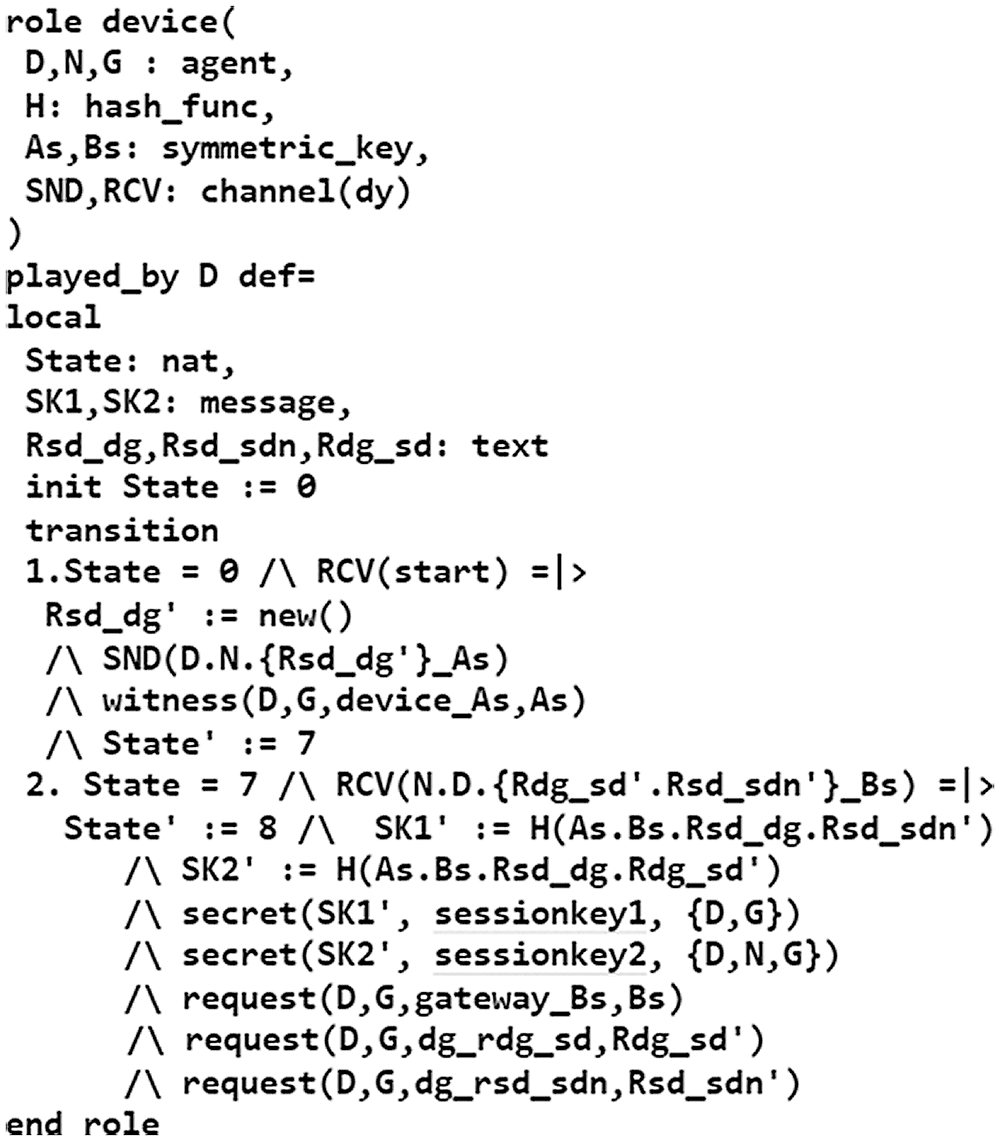
Figure 4: Specification of the
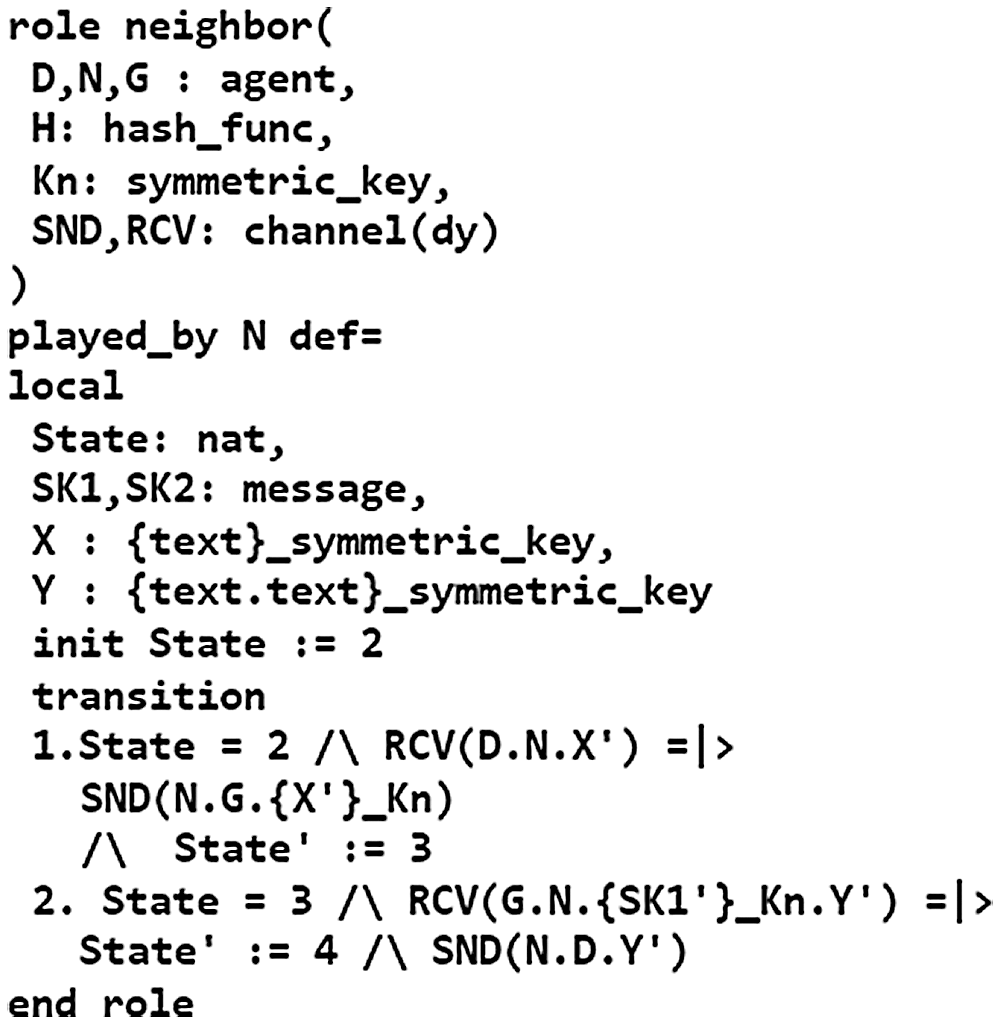
Figure 5: Specification of the
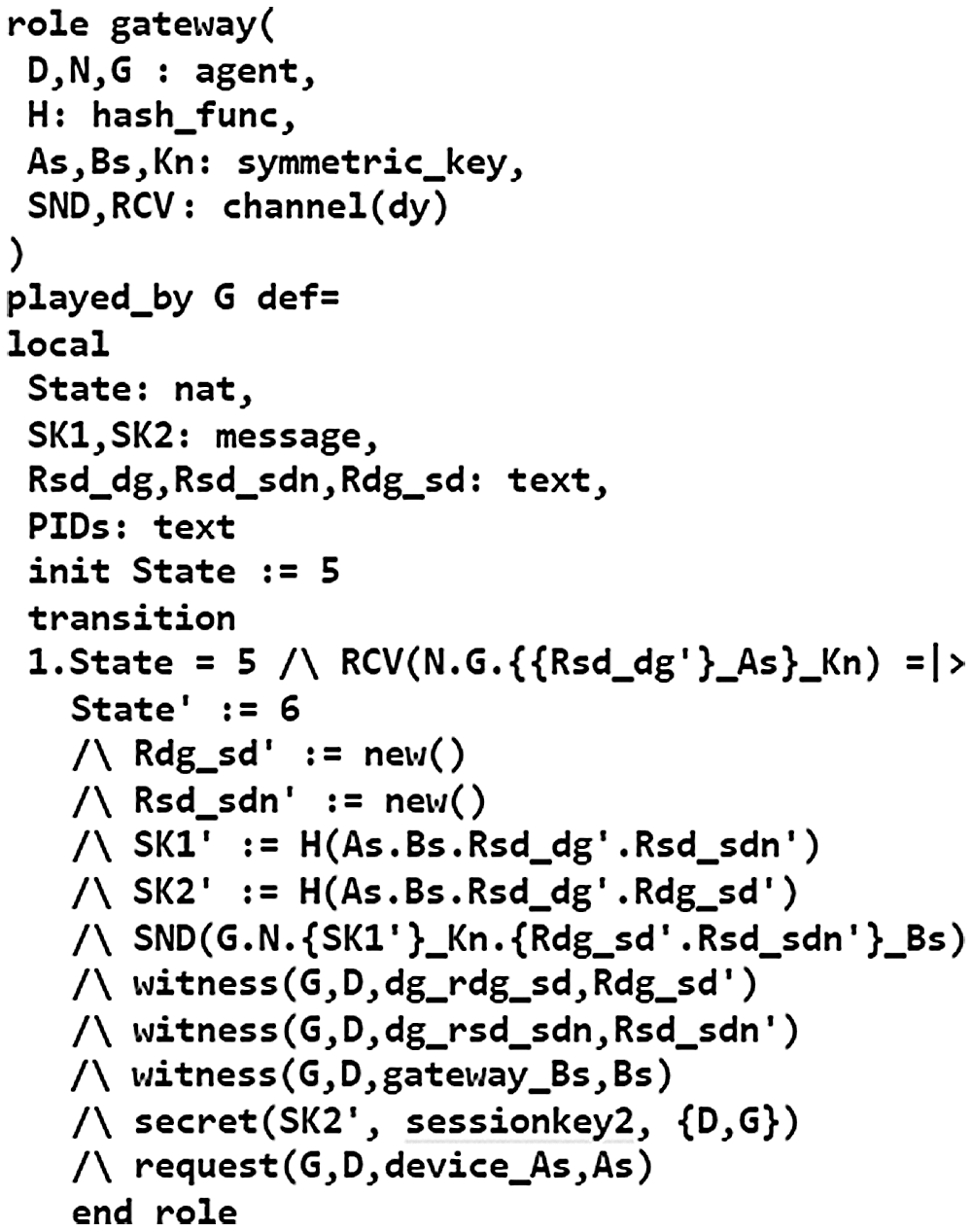
Figure 6: Specification of the
Since the communication between SDS and SDN is untrusted during the authentication process, an 802.15.4 frame exchanged between SDS and SDN does not carry the signature which results in a size of 36 bytes for the header and footer. On the other hand, a frame exchanged within the trusted network of DFM requires the full 52-byte 802.15.4 header and footer. In addition, we consider the 1+0 encoding proposed for NDN packets [33]. Tab. 3 shows the fields and their corresponding sizes for NDN Interest and Data packets, where ST is the total size of name components TL (1B * number of name components), SN is the total size of the name values, and SC is the total size of the content. We assume that ID and PID are 4 bytes, a random number is 8 bytes, and outputs of electric signature, hash, and encryption operations are 16 bytes. Prefixes (
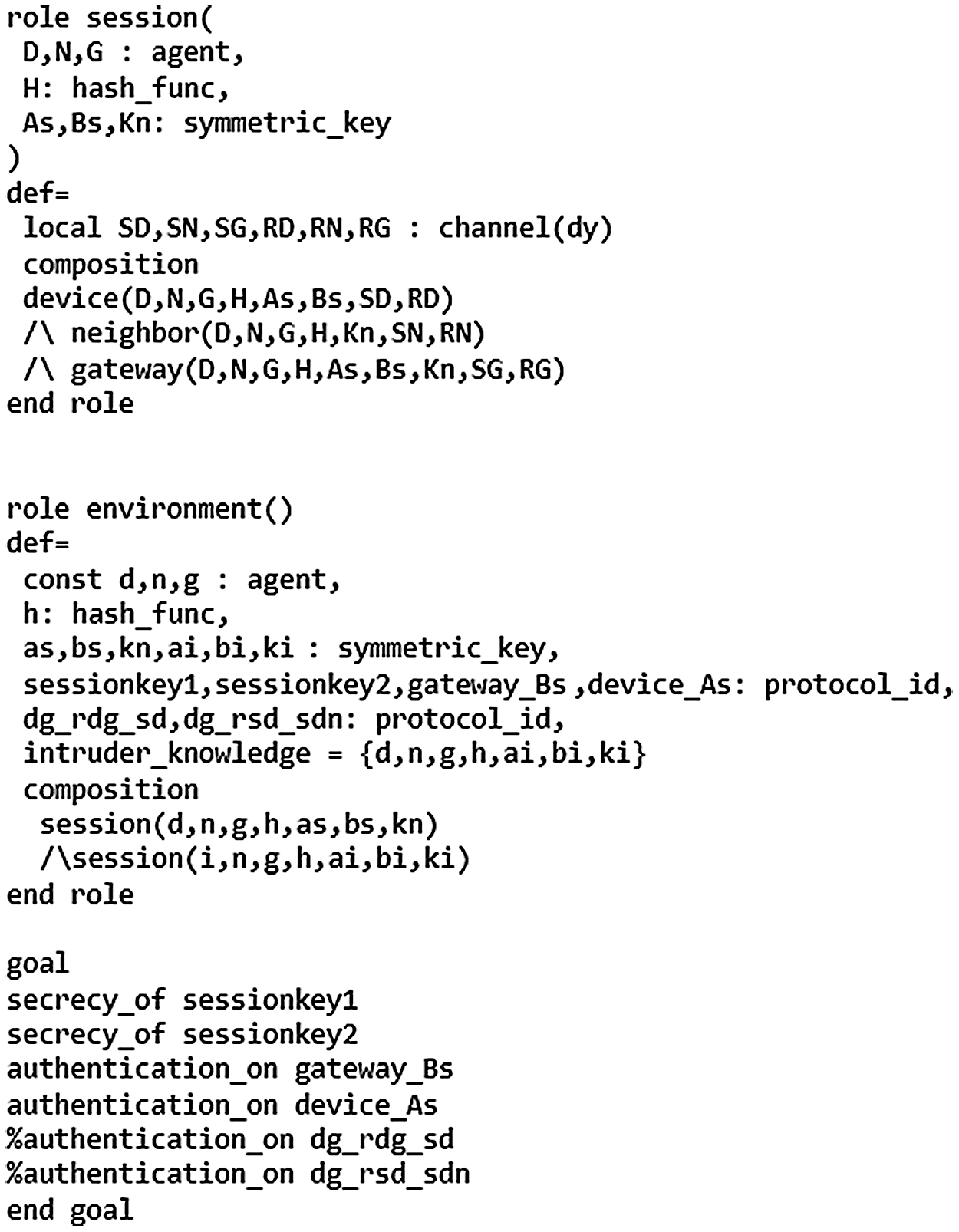
Figure 7: Specification of the
Tab. 5 compares the cryptographic operations performed by the proposed scheme with those of OnboardICNg and LASeR. In the table, ‘TH’, ‘TE’, ‘TD’, ‘TM’, and ‘THM’ represent execution times of operations of hash. AES-128 encryption and decryption, AES-CMAC, and HMAC, respectively. To measure the computation times of cryptographic operations, we used a Raspberry Pi 3 board as the smart device running OpenSSL C programming language libraries. The measured computation times of AES-128 encryption, AES-128 decryption, SHA-256, AES-CMAC, and HMAC are
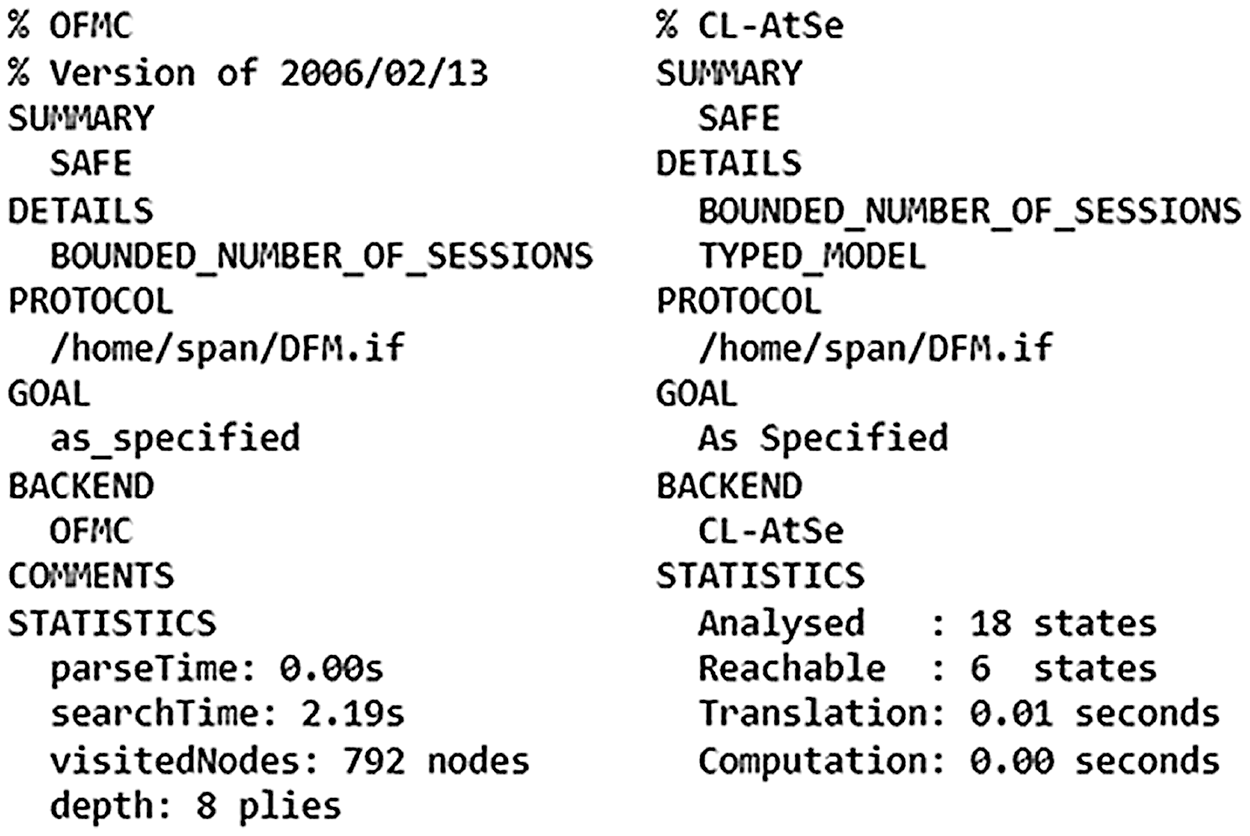
Figure 8: Outputs of OFMC and CL-AtSe backends


We estimated the computational energy cost by using the formula E = V * I * t, where V is the voltage of the input power, I is the current of the circuit, and t is the computation time. Both V and I were obtained from the Raspberry Pi data sheet [34,35]. We estimated the communication energy cost by using the energy cost of sending and receiving one bit on the Raspberry Pi, which was measured as


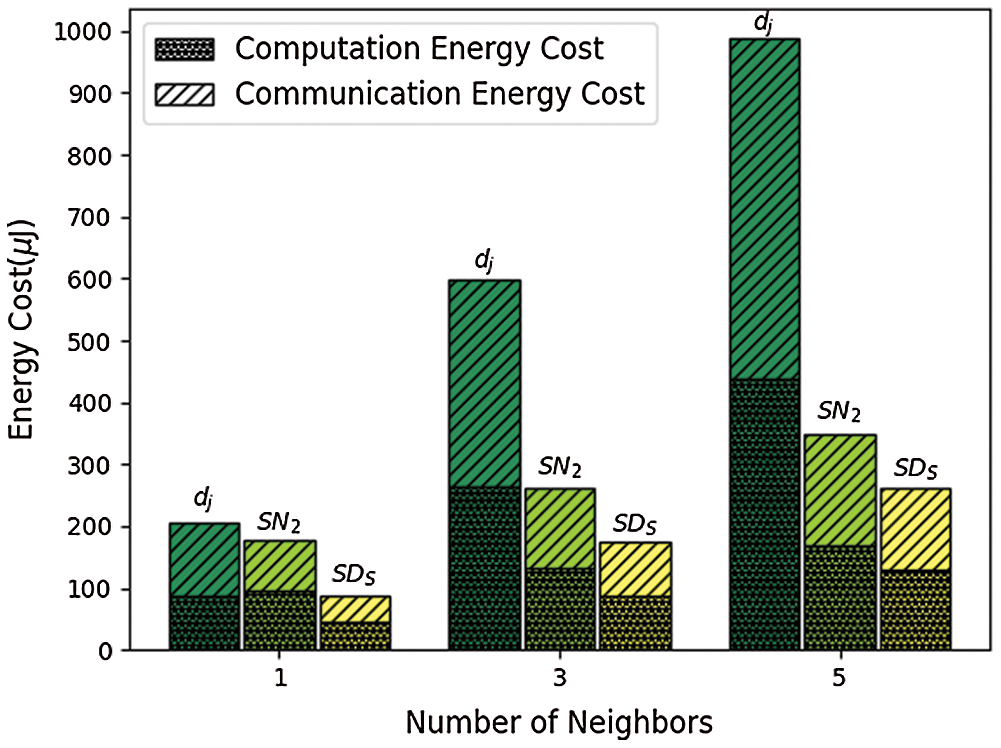
Figure 9: Comparison of energy costs (
In this paper, we propose a new lightweight anonymous device authentication scheme for NDN-based DFM. We perform an informal analysis of security requirements satisfied by the proposed scheme. Formal security verification of the proposed is also carried out by using the popular AVISPA tool. We conduct a performance evaluation to compare the computational, communication, and energy costs of the proposed scheme with those of other schemes. The results of our security analysis and performance evaluation reveal that the proposed scheme has lower computational and communication overheads than other state-of-the-art schemes. In future, we plan to develop an efficient group key agreement scheme for smart devices in information-centric DMF. We will also research how to perform secure and reliable access control of smart devices in information-centric DMF.
Funding Statement: This material is based upon work funded by the National Science Foundation EPSCoR Cooperative Agreement OIA-1757207.
Conflicts of Interest: The authors declare that they have no conflicts of interest to report regarding the present study.
1. S. Lakshminarayana, A. Kammoun, M. Debbah and H. V. Poor, “Data driven false data injection attacks against power grid: A random matrix approach,” arXiv preprint, vol. 2002.02519, pp. 635–646, 2020. [Google Scholar]
2. O. M. Butt, M. Zulqarnain and T. M. Butt, “Recent advancement in smart grid technology: Future prospects in the electrical power network,” Ain Shams Engineering Journal, vol. 12, no. 1, pp. 687–695, 2021. [Google Scholar]
3. J. Wang, L. M. Costa and B. M. Cisse, “From distribution feeder to microgrid: An insight on opportunities and challenges,” in Proc. of IEEE Int. Conf. on Power System Technology, Wollongong, Australia, pp. 1–6, 2016. [Google Scholar]
4. Y. Yan, Y. Qian, H. Sharif and D. Tipper, “A survey on smart grid communication infrastructures: Motivations, requirements and challenges,” IEEE Communications Surveys and Tutorials, vol. 15, no. 1, pp. 5–20, 2013. [Google Scholar]
5. J. Lee, J. P. Berard, G. Razeghi and S. Samuelsen, “Maximizing PV hosting capacity of distribution feeder microgrid,” Applied Energy, vol. 2020, pp. 261, 2020. [Google Scholar]
6. R. Tourani, S. Misra, T. Mick, S. Brahma, M. Biswal et al., “iCenS: An information-centric smart grid network architecture,” in Proc. of 2016 IEEE Int. Conf. on Smart Grid Communications, Sydney, Australia, pp. 417–422, 2016. [Google Scholar]
7. G. Ravikumar, D. Ameme, S. Misra, S. Brahma, R. Tourani et al., “An information-centric network architecture for wide area measurement systems,” IEEE Transactions on Smart Grid, vol. 11, no. 4, pp. 3418–3427, 2020. [Google Scholar]
8. W. K. Chai, N. Wang, K. V. Katsaros, G. Kamel, G. Pavlou et al., “An information-centric communication infrastructure for real-time state estimation of active distribution networks,” IEEE Trans. on Smart Grid, vol. 6, no. 4, pp. 2134–2146, 2015. [Google Scholar]
9. K. Yu, L. Zhu, Z. Wen, A. Mohammad, Z. Zhou et al., “CCNAMI: Performance evaluation of content-centric networking approach for advanced metering infrastructure in smart grid,” in Proc. of 2014 IEEE Int. Workshop on Applied Measurements for Power Systems, Aachen, French, pp. 1–6, 2014. [Google Scholar]
10. S. H. Bouk, S. H. Ahmed, D. Kim and H. Song, “Named-datanetworking-based ITS for smart cities,” IEEE Communications Magazine, vol. 55, no. 1, pp. 105–111, 2017. [Google Scholar]
11. S. Arshad, M. A. Azam, S. H. Ahmed and J. Loo, “Towards information-centric networking (ICN) naming for internet of things (IoTThe case of smart campus,” in Proc. of the Int. Conf. on Future Networks and Distributed Systems, Cambridge, UK, pp. 1–6, 2017. [Google Scholar]
12. M. Amadeo, C. Campolo, A. Iera and A. Molinaro, “Information centric networking in IoT scenarios: The case of a smart home,” in Proc. of 2015 IEEE Int. Conf. on Communications, London, UK, pp. 648–653, 2015. [Google Scholar]
13. M. Chen, “NDNC-BAN: Supporting rich media healthcare services via named data networking in cloud-assisted wireless body area networks,” Information Sciences, vol. 284, pp. 142–156, 2014. [Google Scholar]
14. S. Garg, K. Kaur, G. Kaddoum, J. J. P. C. Rodrigues and M. Guizani, “Secure and lightweight authentication scheme for smart metering infrastructure in smart grid,” IEEE Transactions on Industrial Informatics, vol. 16, no. 5, pp. 3548–3557, 2020. [Google Scholar]
15. N. Kumar, G. S. Aujla, A. K. Das and M. Conti, “ECCAuth: A secure authentication protocol for demand response management in a smart grid system,” IEEE Transactions on Industrial Informatics, vol. 15, no. 12, pp. 6572–6582, 2019. [Google Scholar]
16. Y. Chen, J. Martınez, P. Castillejo and L. Lopez, “A bilinear map pairing based authentication scheme for smart grid communications: PAuth,” IEEE Access, vol. 7, pp. 22633–22643, 2019. [Google Scholar]
17. L. Zhang, L. Zhao, S. Yin, C. H. Chi, R. Liu et al., “A lightweight authentication scheme with privacy protection for smart grid communications,” Future Generation Computer Systems, vol. 100, no. 9, pp. 770–778, 2019. [Google Scholar]
18. A. Compagno, M. Conti and R. Droms, “OnboardICNg: A secure protocol for on-boarding IoT devices in ICN,” in Proc. of the 3rd ACM Conf. on Information-Centric Networking, Kyoto, Japan, pp. 166–175, 2016. [Google Scholar]
19. M. Enguehard, R. Droms and D. Rossi, “On the cost of secure association of information centric things,” in Proc. of the 3rd ACM Conf. on Information-Centric Networking, Kyoto, Japan, pp. 207–208, 2016. [Google Scholar]
20. T. Mick, R. Tourani and S. Misra, “LASeR: Lightweight authentication and secured routing for NDN IoT in control cities,” IEEE Internet of Things Journal, vol. 5, no. 2, pp. 755–764, 2018. [Google Scholar]
21. L. Vigano, “Automated security protocol analysis with the AVISPA tool,” Electronic Notes in Theoretical Computer Science, vol. 155, no. 1, pp. 61–86, 2006. [Google Scholar]
22. J. Shi and B. Zhang, “NDNLP: A link protocol for NDN, NDN Team, NDN,” Technical Report NDN-0006, 2012. [Google Scholar]
23. C. Gundogan, P. Kietzmann, T. C. Schmidt and M. Wahlisch, “ICNLoWPAN–named-data networking for low power IoT networks,” in Proc. of 2019 IFIP Networking Conf., Warsaw, Poland, pp. 1–9, 2019. [Google Scholar]
24. P. Kumar, A. Gurtov, J. Iinatti, M. Ylianttila and M. Sain, “Lightweight and secure session-key establishment scheme in smart home environments,” IEEE Sensors Journal, vol. 16, no. 1, pp. 254–264, 2016. [Google Scholar]
25. D. Dolev and A. Yao, “On the security of public key protocols,” IEEE Transactions on Information Theory, vol. 29, no. 2, pp. 198–208, 1983. [Google Scholar]
26. R. Canetti and H. Krawczyk, “Analysis of key-exchange protocols and their use for building secure channels,” in Proc. of Int. Conf. on the Theory and Applications of Cryptographic Techniques, Innsbruck, Austria, pp. 453–474, 2001. [Google Scholar]
27. T. S. Messerges, E. A. Dabbish and R. H. Sloan, “Examining smartcard security under the threat of power analysis attacks,” IEEE Transactions on Computers, vol. 51, no. 5, pp. 541–552, 2002. [Google Scholar]
28. M. Nabeel, S. Kerr, X. Ding and E. Bertino, “Authentication and key management for advanced metering infrastructures utilizing physically unclonable functions,” in 2012 IEEE Third Int. Conf. on Smart Grid Communications, Tainan, pp. 324–329, 2012. [Google Scholar]
29. S. Dey and A. Hossain, “Session-key establishment and authentication in a smart home network using public key cryptography,” IEEE Sensors Letters, vol. 3, no. 4, pp. 1–4, 2019. [Google Scholar]
30. A. K. Das, M. Wazid, A. R. Yannam, J. J. P. C. Rodrigues and Y. Park, “Provably secure ECC-based device access control and key agreement protocol for IoT environment,” IEEE Access, vol. 7, pp. 55382–55397, 2019. [Google Scholar]
31. M. Wazid, A. K. Das, V. Odelu, N. Kumar and W. Susilo, “Secure remote user authenticated key establishment protocol for smart home environment,” IEEE Trans. on Dependable and Secure Computing, vol. 17, no. 2, pp. 391–406, 2020. [Google Scholar]
32. J. Srinivas, A. K. Das, M. Wazid and N. Kumar, “Anonymous lightweight chaotic map-based authenticated key agreement protocol for industrial internet of things,” IEEE Trans. on Dependable and Secure Computing, vol. 17, no. 6, pp. 1133–1146, 2020. [Google Scholar]
33. M. Enguehard, R. E. Droms and D. Rossi, “On the cost of geographic forwarding for information-centric things,” IEEE Transactions on Green Communications and Networking, vol. 2, no. 4, pp. 1150–1163, 2018. [Google Scholar]
34. Power supply, https://www.raspberrypi.org/documentation/hardware/raspberrypi/power/README.md, (accessed on July 10, 2020). [Google Scholar]
35. Raspberry Pi 3 model B+, https://static.raspberrypi.org/files/product-briefs/Raspberry-Pi-Model-Bplus-Product-Brief.pdf, (accessed on July 10, 2020). [Google Scholar]
 | This work is licensed under a Creative Commons Attribution 4.0 International License, which permits unrestricted use, distribution, and reproduction in any medium, provided the original work is properly cited. |